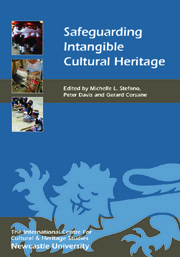Book contents
- Frontmatter
- Contents
- List of Illustrations
- Acknowledgments
- Touching the Intangible: An Introduction
- NEGOTIATING AND VALUING THE INTANGIBLE
- APPLYING THE INTANGIBLE CULTURAL HERITAGE CONCEPT
- 8 Reflections on the Implementation of the UNESCO 2003 Convention for the Safeguarding of Intangible Cultural Heritage in France
- 9 Government and Intangible Heritage in Australia
- 10 Proud to be Dutch? Intangible Heritage and National Identity in the Netherlands
- 11 Intangible Cultural Heritage in Wales
- 12 Conversation Piece: Intangible Cultural Heritage in Botswana
- 13 The UNESCO Convention for the Safeguarding of Intangible Cultural Heritage and its Implications for Sustaining Culture in Nova Scotia
- ON THE GROUND: SAFEGUARDING THE INTANGIBLE
- List of Contributors
- Index
13 - The UNESCO Convention for the Safeguarding of Intangible Cultural Heritage and its Implications for Sustaining Culture in Nova Scotia
from APPLYING THE INTANGIBLE CULTURAL HERITAGE CONCEPT
Published online by Cambridge University Press: 05 February 2013
- Frontmatter
- Contents
- List of Illustrations
- Acknowledgments
- Touching the Intangible: An Introduction
- NEGOTIATING AND VALUING THE INTANGIBLE
- APPLYING THE INTANGIBLE CULTURAL HERITAGE CONCEPT
- 8 Reflections on the Implementation of the UNESCO 2003 Convention for the Safeguarding of Intangible Cultural Heritage in France
- 9 Government and Intangible Heritage in Australia
- 10 Proud to be Dutch? Intangible Heritage and National Identity in the Netherlands
- 11 Intangible Cultural Heritage in Wales
- 12 Conversation Piece: Intangible Cultural Heritage in Botswana
- 13 The UNESCO Convention for the Safeguarding of Intangible Cultural Heritage and its Implications for Sustaining Culture in Nova Scotia
- ON THE GROUND: SAFEGUARDING THE INTANGIBLE
- List of Contributors
- Index
Summary
INTRODUCTION
For many people in the Canadian government and civic society, ‘heritage’ means material ‘things’, including buildings, artefacts and important objects. With respect to Nova Scotia, we have a Heritage Property Act (1989) and a Special Places Protection Act (1989) to ‘Provide for the Preservation, Regulation and Study of Archaeological and Historical Remains and Paleontological and Ecological Sites’. We also have numerous local, provincial and federal museums throughout the province that conduct research, conserve artefacts, produce exhibits and educate people about various aspects of Nova Scotia heritage, such as Les Trois Pignons Centre Culturel, the Museum of Industry and Pier 21, and Canada's Immigration Museum. The Heritage Division of the Nova Scotia Department of Tourism, Culture and Heritage currently provides heritage-related services and programmes throughout the province by operating 27 provincial museums and maintaining a provincial collection of artefacts and specimens.
In general, Canada has responded positively to the 1972 Convention Concerning the Protection of the World Cultural and Natural Heritage, with the designation of 14 World Heritage Sites, including Québec City, Québec, L'Anse aux Meadows Viking Settlement and Gros Morne National Park in Newfoundland, and the town of Lunenburg in Nova Scotia. Two new Canadian sites have been designated in 2009: the Rideau Canal in Ottawa and the fossil cliffs of Joggins, Nova Scotia. Accordingly, many Canadian communities, governments and individuals have supported the idea that the concept of ‘heritage’ is synonymous with our important physical and architectural monuments.
- Type
- Chapter
- Information
- Safeguarding Intangible Cultural Heritage , pp. 153 - 162Publisher: Boydell & BrewerPrint publication year: 2012



